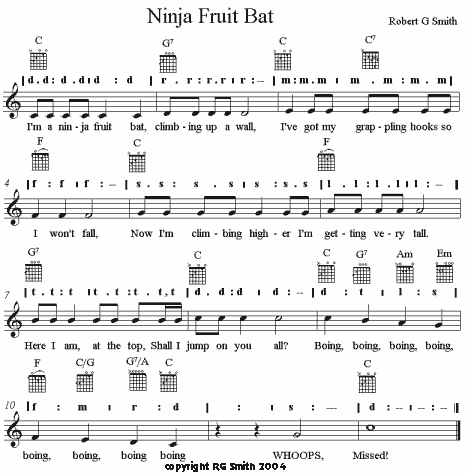Lesson
Preparation:
Previous Knowledge:
(state the prior knowledge, skills and attitudes
relevant to this lesson)
It is likely that many Pacific Island students,
particularly those who are Protestant Christians, will be familiar with
and able to interpret Solfege - Tonic Sol-fa Notation. The similarity
between this system of notating music and Hindi notation (in common use
in Fiji) is probably no accident. One historical commentary has it that
Guido d'Arezzo's
ideas for a notation in Europe which preceded contemporary solfege was
inspired by the Indian Sa Re Ga Ma. A superficial comparison of both
certainly suggests a relationship. For example both notation systems
have 're' as their second pitch.
General Aim:
The intention of this lesson is to renew the
understanding of students who have already worked with Solfege and to
introduce other students to the system. By the end of the lesson
students should be able to read, and perform some relatively easy songs
written in solfege.
Specific Behavioural Objectives
At the end of this lesson, students should be
able to:
1. cognitive
& metacognitive
- recognise pitch and rhythm shifts as these are
indicated by the solfege symbols.
2. Affective
- Participate positively in discussion and
rehearsal
- Perform songs in a constructive and
collaborative manner
3. psychomotor
- interpret solfege symbols in the performance
of easy songs written in this notation system.
Teaching Aids and resource materials:
(state the
teaching aids and resource materials to be prepared or
collected)
Songs notated using Solfege music symbols
Lesson Steps
Focus Question
What is solfege and how do we write it?
Stimulus
Either - display a chart of music written in
solfege on the wall in front of students
Or - Distribute photocopies of the music for students to share.
How would they describe what they see?
Consider
Solfege - Tonic Solfa - is a way of notating
music.
It uses symbols to represent pitched sounds and symbols to represent
the movement - rhythm and metre - of music
It assumes the music moves around a 'home' note of pitch, called
the tonic. (hence the name 'tonic' sol-fa.)
The seven notes of any diatonic Western major scale, no matter what
'key' are represented as (rising from the lowest pitch)
| d1 |
or |
doh1 |
for |
the tonic or home note an octave above |
| t |
or |
ti |
for |
the leadning or seventh note that leads to
the tonic above |
| l |
or |
la (lah) |
for |
the sub-mediant or sixth note |
| s |
or |
so (soh) |
for |
the dominant of fifth note (regarded as
'second' to the tonic) |
| f |
or |
fa (fah) |
for |
the sub-dominant or the fourth note in the
sequence upwards |
| m |
or |
mi |
for |
the mediant of third note in the sequence
upwards |
| r |
or |
re (ray) |
for |
the supertonic or next note above it |
| d |
or |
doh |
for |
the tonic or home note |
Experience
Share singing these short notated exercises with
the class (For the present, perform the rhythms are steady 'walking'
beats (crotchets or quarter notes)
1.
d r m
m m r
d d
2.
m s l
s m s
l s
3.
m r d
r m m
m m
4.
d m s
m d m
s m
If the notated music goes above ti,
or below low doh, a supertext or subtext 1 is used to show that the
pitches are not within the normal scale.
So
ti below doh is shown as t1
And high doh is shown as
d1
Rhythm and Metre
The beats of music written in solfege are
indicated by vertical lines, colons and full stops
If the music is in two-beat time crotchets (walking beats) are
indicated by colons
2/4
| d : d | r :
r | m : r |
d : --- ||
In the last measure or bar above
the long dashes show that doh is held as a two beat note.
3/4
| d : d : d | r :
r : r | m :
m : r | d : --- : --- ||
In the last measure or bar above
the long dashes show that doh is held as a three beat note.
4/4
| d : d \ d : d |
r : r \ r : r |
m : --- \ --- : --- ||
In four beat metre the third beat
is indicated by a half line. In the last measure or bar above the long
dashes show that doh is held as a four beat note.
Now take another look at the song 'Ninja Fruit Bat'!'
|


